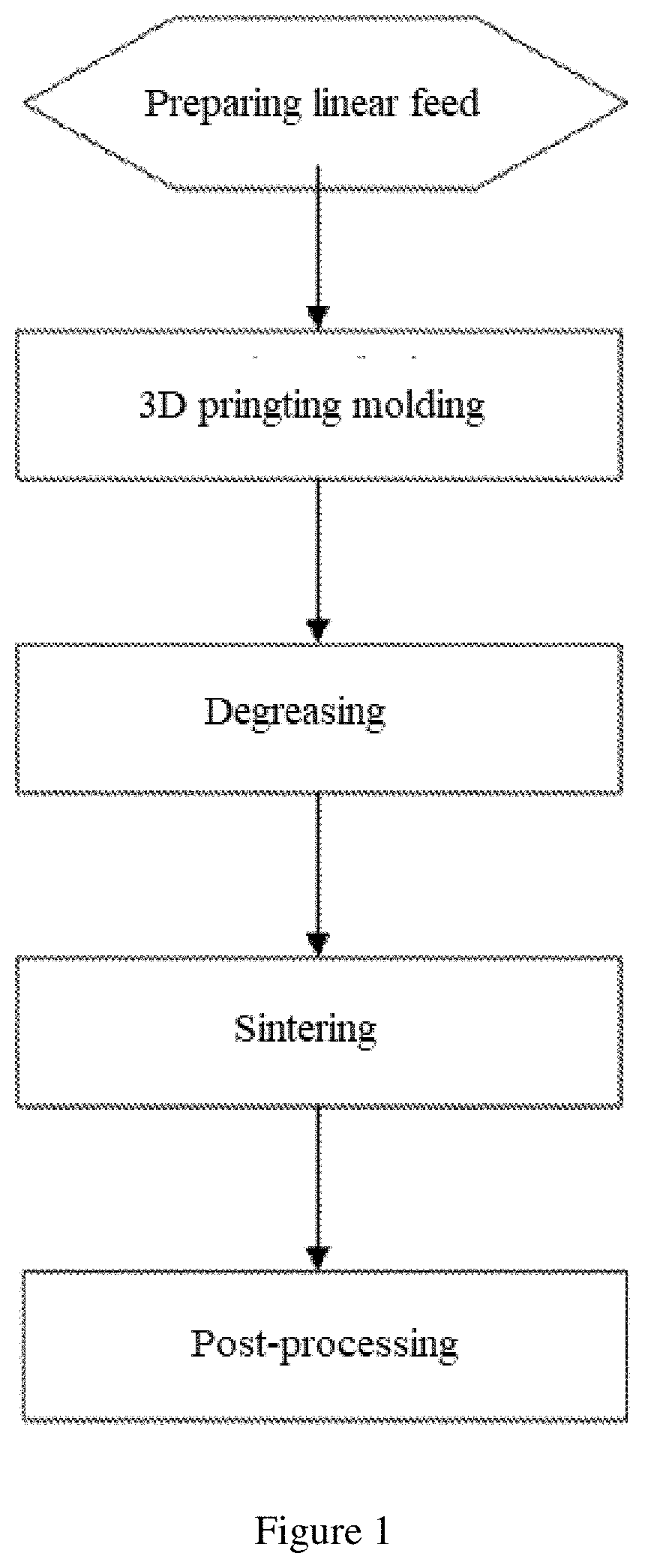3D printing material, preparation method and use thereof
a technology of 3d printing and materials, applied in the field of 3d printing, can solve the problems of low accuracy, complex and expensive equipment, waste of raw materials, etc., and achieve the effects of small high-temperature sintering shrinkage, less variation, and increased product yield
- Summary
- Abstract
- Description
- Claims
- Application Information
AI Technical Summary
Benefits of technology
Problems solved by technology
Method used
Image
Examples
embodiment 1
[0088]A high-solid content non-metal 3D printing material, is linear, and it comprises, in percent by volume, 44 vol % of a zirconia ceramic powder, 55.5 vol % of a first binder and 0.5 vol % of a second binder.
[0089]The preparation method of the high-solid content non-metal 3D printing material comprises the following steps:
[0090](1) The zirconia ceramic powder with a size distribution D90 of 0.5 to 1.0 μm was mixed with the second binder (a phenolic resin solution) and then spray drying granulated at 120° C. to form semi-solidified powder agglomerate particles which has a size distribution D90 of 30 to 100 μm;
[0091](2) The zirconia ceramic powder was mixed with the first binder, the first binder comprises: 85 wt % polyoxymethylene, 11 wt % backbone polymer, 1 wt % plasticizer, 0.5 wt % antioxidant, 0.5 wt % heat stabilizer, 1 wt % toughening agent, and 1 wt % lubricant polymer; the raw materials was added into an internal mixer, mixing-milling at 180° C. for 1 h;
[0092](3) The mixe...
embodiment 2
[0098]A high-solid content non-metal 3D printing material, is linear, and it comprises, in percent by volume, 40 vol % of a zirconia ceramic powder, 59.2 vol % of a first binder and 0.8 vol % of a second binder.
[0099]The preparation method of the high-solid content non-metal 3D printing material comprises the following steps:
[0100](1) The zirconia ceramic powder with a size distribution D90 of 0.5 to 1.0 μm was mixed with the second binder (a phenolic resin solution) and then spray drying granulated at 120° C. to form semi-solidified powder agglomerates which are pellets having a size distribution D90 of 30 to 100 μm;
[0101](2) The zirconia ceramic powder was mixed with the first binder, the first binder comprises: 85 wt % polyoxymethylene, 11 wt % backbone polymer, 1 wt % plasticizer, 0.5 wt % antioxidant, 0.5 wt % heat stabilizer, 1 wt % toughening agent, and 1 wt % lubricant polymer; the raw materials was added into an internal mixer, mixing-milling at 180° C. for 1 h;
[0102](3) Th...
embodiment 3
[0108]A high-solid content non-metal 3D printing material, is linear, and it comprises, in percent by volume, 50 vol % of an alumina-zirconia ceramic powder, 49 vol % of a first binder and 1.0 vol % of a second binder.
[0109]The preparation method of the high-solid content non-metal 3D printing material comprises the following steps:
[0110](1) The alumina-zirconia ceramic powder with a size distribution D90 of 0.5 to 1.0 μm was mixed with the second binder (a phenolic resin solution) and then spray drying granulated at 120° C. to form semi-solidified powder agglomerate particles which are pellets having a size distribution D90 of 30 to 100 μm;
[0111](2) The alumina-zirconia ceramic powder was mixed with the first binder, the first binder comprises: 85 wt % polyoxymethylene, 11 wt % backbone polymer, 1 wt % plasticizer, 0.5 wt % antioxidant, 0.5 wt % heat stabilizer, 1 wt % toughening agent, and 1 wt % lubricant polymer; the raw materials was added into an internal mixer, mixing-milling...
PUM
| Property | Measurement | Unit |
|---|---|---|
| diameter | aaaaa | aaaaa |
| size distribution D90 | aaaaa | aaaaa |
| size distribution D90 | aaaaa | aaaaa |
Abstract
Description
Claims
Application Information
 Login to View More
Login to View More - R&D
- Intellectual Property
- Life Sciences
- Materials
- Tech Scout
- Unparalleled Data Quality
- Higher Quality Content
- 60% Fewer Hallucinations
Browse by: Latest US Patents, China's latest patents, Technical Efficacy Thesaurus, Application Domain, Technology Topic, Popular Technical Reports.
© 2025 PatSnap. All rights reserved.Legal|Privacy policy|Modern Slavery Act Transparency Statement|Sitemap|About US| Contact US: help@patsnap.com

